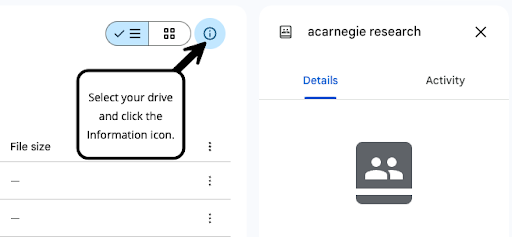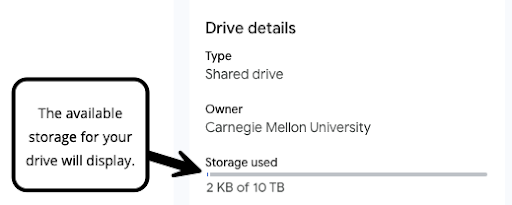Making the Most of Your New Google Shared Drive for Research
We are pleased to announce that Computing Services and the Office of Research Computing and Data (ORCD) will provide all faculty with a 10 TB Google Shared Drive for Research on Google Workspace beginning in April 2025 to support research storage and collaboration.
Access Your New Drive
- Visit drive.google.com.
- Click Shared Drives on the left sidebar.
- Locate the drive named [Your Andrew userID] Research.
New Google Shared Drive for Research Quick Start
 1. Understand Google file structure and permissions.
1. Understand Google file structure and permissions.
- Google uses waterfall permissions. In Google Drive, waterfall permissions mean that when you grant access to a folder, the permissions automatically extend to all its subfolders and files.
- Plan before you organize your drive. Granting access to your entire shared drive could pose a risk to your data. Consider who you want to give access to and what access levels they should have.
 2. Set up your structure.
2. Set up your structure.
- Create a folder hierarchy. Will you create folders for each research project? Will you create folders for classes and subfolders for sections? View Examples
- Determine a naming convention. Do files need to contain a specific identifier? Are words separated by spaces, dashes, or underscores? Consider numbering folders with leading zeros to simplify organization and place them in your preferred order.
- Keep confidential materials separate. If any materials are confidential, consider separating those from other documents on your drive. This reduces the risk of accidentally granting access to sensitive materials.
 3. Set up permissions.
3. Set up permissions.
- Entire Shared Drive access. Regarding your entire Google Shared Drive for Research, we recommend that only you and a trusted assistant are managers of your drive. Otherwise, those with manager permissions to the entire drive could accidentally delete it without your knowledge. View examples.
- Folder/File level access. Whenever possible, we recommend granting access at the folder level instead of the file level. Use project-specific folders to grant access to relevant team members, as managing individual file permissions can be cumbersome and should be avoided unless necessary.
 4. Determine any time restraints.
4. Determine any time restraints.
- Consider the length of access. For example, students taking a single class with you may only need access for a semester, while other collaborators, such as upper-level graduate students and research staff, may need access for a longer period of time.
- Set a calendar reminder to update access. Set a recurring calendar event to review sharing every quarter and remove collaborators no longer associated with your work. To assist with this, you can also ask students or researchers to remove themselves from folders or files at the end of a project or semester.
 5. Plan for required retention.
5. Plan for required retention.
- Compliance is crucial. Consult your sponsor, data management plan, and/or data use agreements to determine how long you need to keep your work.
- Offload archival work. Archivable work may be a good candidate for Public Cloud Services or on-campus resources such as Kilt Hub. To ensure you have enough space, consider limiting your Google Google Shared Drive for Research to work-in-progress.
Examples
Folder Hierarchy
Research Project Structure
- 01 Project Administration
- 02 Raw Data
- 03 Analysis
- 04 Literature
- 05 Publications
- 06 Media
- 07 Documentation
Access
- Shared Drive
- Manager (yourself, a trusted colleague)
- Research Project - Project Folder
- Content manager (senior researchers/PIs, postdocs)
- Contributor (graduate students)
- Commenter (external collaborators)
- Viewer (project partners)
For more information on permissions, visit How File Access Works in shared drives.
Frequently Asked Questions
Are there limitations around what I store or how I transfer content to my new shared drive?
The only limits that apply are Google’s general shared drive limitations.
For help with bulk transfers, consider scheduling a consultation with a member of our Google Team.
Can something deleted from my Google Shared Drive for Research be recovered?
Google’s standard 30-day retention policy applies to your Google Shared Drive for Research, so please be careful when deciding to delete content—especially if you are working in Google Drive for Desktop.
How do I view my available storage?
To view the available storage on your shared drive, navigate to the drive, then click the Information (i) icon (upper right).
Click the information Icon.

Scroll down to Storage Used.

Should I add other managers to my shared drive?
We recommend that only you and a trusted assistant are managers of your drive. Otherwise, those with manager permissions to the entire drive could accidentally delete it without your knowledge.
Should I grant students access to my drive?
Depending on the type of work a student is conducting on your behalf, consider creating a separate folder that contains items the student will need access to.
What if I need more storage?
Faculty and staff may purchase additional storage to support administrative, academic, and research needs if they require more than their limit. We provide additional storage at the same rate that Google charges CMU, with no added fees.
Storage is currently available in the following increments:
- 250 GB ($36.00/yr.)
- 500 GB ($72.00/yr.)
- 1 TB ($144.00/yr.)
- 2 TB ($288.00/yr.)
- 10 TB ($1,440.00/yr.)
To request additional storage, email it-help@cmu.edu with a valid Oracle string, and we will increase your storage limit. Note: Students requiring more storage for research work should speak with their faculty advisor regarding where to store their work.
What if Google Workspace's shared drive limitations are a problem?
If you’re interested in setting up an account with one of our public cloud providers or want to learn more, request a no-cost consultation. Students should include a faculty or staff member associated with their project in their consultation.